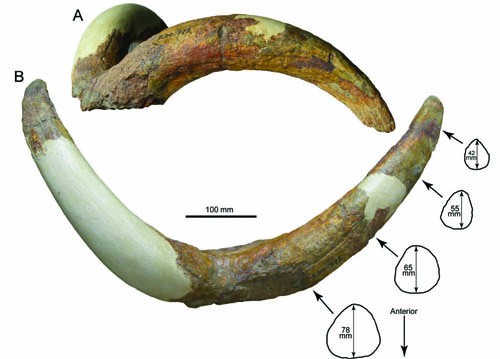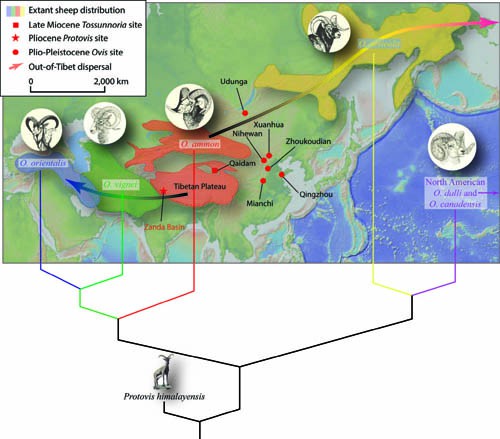Modern argali sheep (Ovis) are widely distributed in a series of mountain ranges such as the Caucasus, Himalayas, Tibetan Plateau, Tianshan-Altai Mountains, Eastern Siberia, and the Rocky Mountains of North America. In Eurasia, argali fossils have only been found in small amounts of dental material from several Pleistocene sites in North China, Eastern Siberia, and Western Europe, but have not been previously recorded on the Tibetan Plateau.
In the recently published international journal "Journal of Vertebrate Paleontology", Wang Xiaoming and others from a joint team of the Institute of Vertebrate Paleontology and Paleoanthropology, Chinese Academy of Sciences and the Los Angeles Museum of Natural History reported the discovery in the Zanda Basin in Tibet. A new genus of fossil sheep, Protovis himalayensis. This discovery not only extends the fossil record of sheep to the Pliocene of the Tibetan Plateau, but also proposes that the Tibetan Plateau, possibly including the Tianshan-Altai Mountains, represents the ancestral area of argali. This basic group is the basis for all modern argali. The most recent common ancestor of the species, and is consistent with the team's previous theory of the origin of ice age animals "walking out of Tibet".
The new fossil materials were collected during field expeditions in 2006 and 2007 from the observation deck site in Zanda County, Tibet Autonomous Region, in the western Himalayas (Institute of Vertebral Paleontology Field Site ZD0712). The holotype specimen (IVPP V18928) is an almost complete pair of male left and right horns, which is the main basis for establishing this new genus and species. The total length of the outer arc at the center of the horn is 443 mm, which is similar to the size of some living species of argali.
The newly discovered extinct sheep has a combination of characteristics that is different from other genera such as argali, blue sheep (Pseudois) and Tossunnoria. It is smaller than the living Asian argali, but like the argali, it has a posteriorly and laterally curved horn center and a partially developed frontal sinus, as well as some transitional traits that tend to be similar to the argali.
The Zada Basin, located between the Himalayas and the Ayla Riju Mountains, was formed in a tectonically active area. Throughout the development of the basin, the basement rock layers of the residual landforms and surrounding mountains provided abundant resources along the shores of the Zanda Ancient Lake. Rough terrain and low gentle hills. The fossil site is not far from an ancient island formed from metamorphic rock basement. These cliffs may have provided protection from predators.
The carbon isotope analysis results of fossil herbivorous mammals in the Zanda Basin indicate that C3 plants dominated the vegetation during the Pliocene. This fact shows that Protosheep, like modern bovids on the Qinghai-Tibet Plateau, also feeds on C3 plants.
The argali ancestors of the Tibetan Plateau occupy the same distribution range as modern argali and have adapted to the cold environment of high altitudes during the Pliocene Epoch. At that time, other areas, including the high-latitude Arctic Circle, were under warmer climate conditions. . This ancestral group quickly evolved to have morphological conditions similar to those of modern argali. When the Quaternary Ice Age arrived about 2.6 million years ago, they had a competitive advantage in surviving in the frozen environment, and thus rapidly spread to the surrounding areas of the Tibetan Plateau and beyond. more distant areas. Most argali species have survived along their Pleistocene dispersal routes, resulting in highly consistent zoogeographic patterns.
"The discovery of primitive sheep in the Himalayas provides another example for our previously proposed "out of Tibet" hypothesis: the argali ancestors adapted to the cold environment of high altitudes during the Pliocene Epoch, and began to migrate from it in the Pleistocene The original living area on the Qinghai-Tibet Plateau spread outwards to North China, northern Siberia and western Asia." Researcher Wang Xiaoming said: "The argali has joined several other mammals, such as big cats, arctic foxes, pure carnivores, etc. The ranks of jackals and woolly rhinos spread beyond the Tibetan Plateau during the Ice Age and became members of the Pleistocene Ice Age fauna."
"New fossil materials and existing molecular biology pedigrees prove that the Qinghai-Tibet Plateau, and possibly the Tianshan-Altai Mountains, represent the origin area of argali," said Dr. Li Qiang, a co-author of the article: "Fortunately, argali have been "The shelter of the mountainous environment may have been an important factor in their ability to escape predation by early humans and survive the extinction event at the end of the Pleistocene, while many of their Ice Age fauna companions did not survive."
This research was funded by the Strategic Priority Science and Technology Project of the Chinese Academy of Sciences, the 973 Project, and the National Natural Science Foundation of China.

Figure 1 The holotype specimen of Himalayan Protoshes, showing the front-side view (A), dorsal view (B), and four cross-sections of the left corner (photo provided by Wang Xiaoming)

Figure 2 Distribution areas of extinct and extant species of Argali in Eurasia and their phylogenetic relationship with Himalayan Argali (photo provided by Wang Xiaoming)

Figure 3
animal tags:
We created this article in conjunction with AI technology, then made sure it was fact-checked and edited by a Animals Top editor.